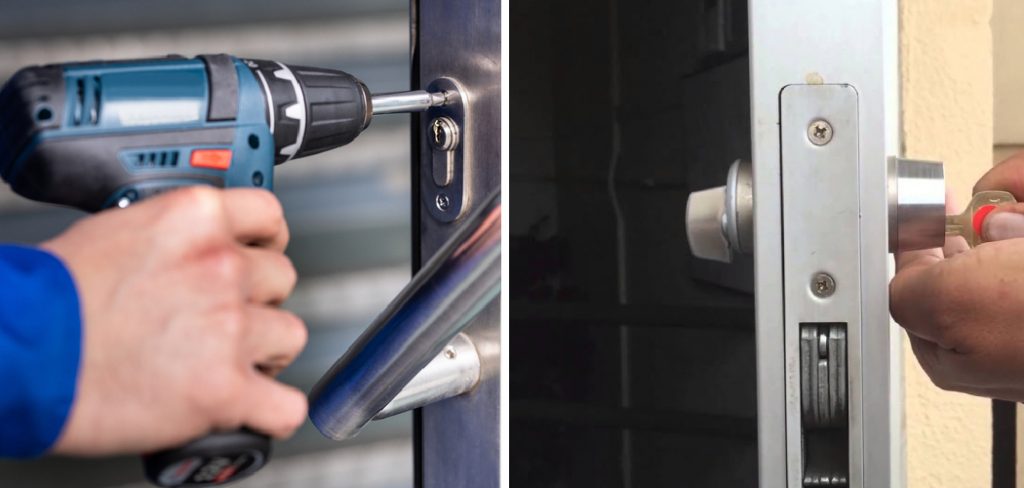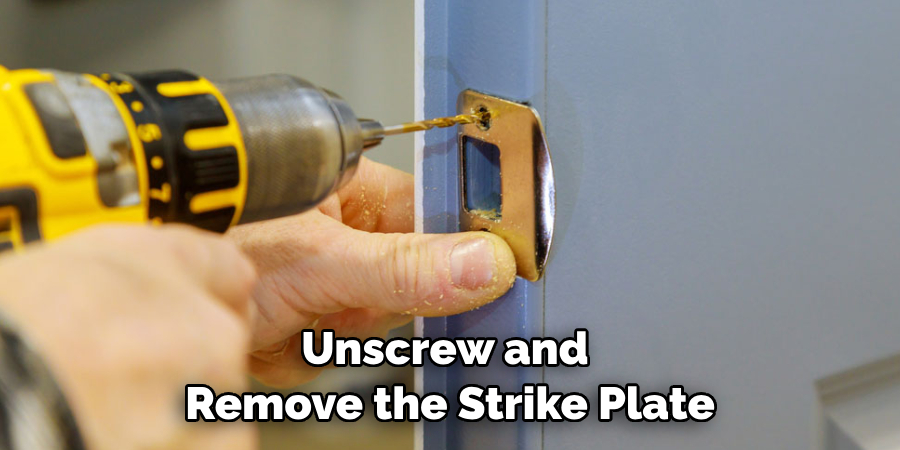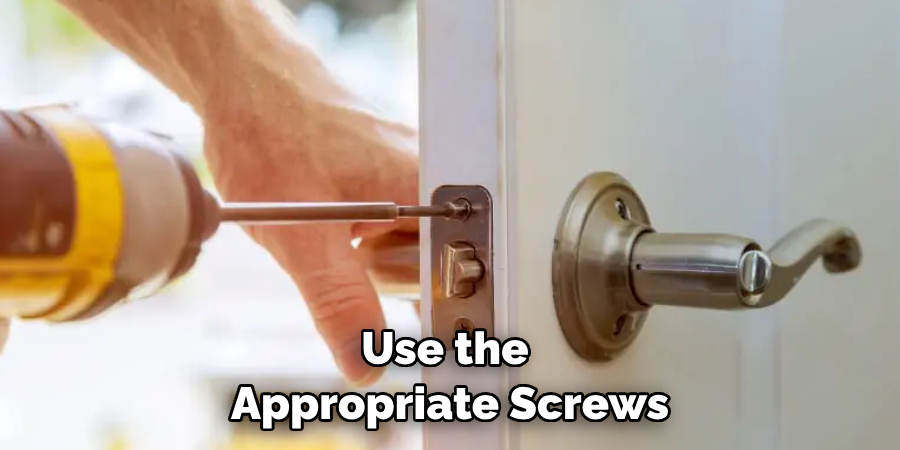Replacing a commercial door lock is a task that often arises due to security upgrades, wear and tear, or the need to change access permissions within a business or commercial property. While it may seem like a complex endeavor, especially for those without extensive locksmithing experience, it’s a manageable process with the right guidance.

In this comprehensive guide, we will explore the step-by-step procedure for how to replace commercial door lock efficiently and effectively.Whether you’re a business owner seeking to enhance security or a facility manager responsible for maintaining access control, this article will provide you with the knowledge and detailed instructions necessary to confidently tackle the task.
Join us as we delve into the intricacies of replacing a commercial door lock, ensuring the safety and security of your workplace or business premises.
The Significance of a Functional Commercial Door Lock
A functional commercial door lock is essential to the security of any business. A broken or defective commercial door lock can allow unwanted guests into the premises, creating a risk of theft for your establishment. Furthermore, it could also compromise the safety and privacy of your customers and staff. Therefore, it is imperative that you replace any malfunctioning locks as soon as possible.
Fortunately, replacing a lock on a commercial door is relatively simple and straightforward. This guide will walk you through the process of installing a new commercial door lock, from choosing the right one to making sure it is properly fitted.
Reasons for Replacing Commercial Door Locks
There can be a variety of reasons why you might need to replace commercial door locks. It could be because you’ve moved into a new premises and the old lock is outdated or damaged, or it could be that your business has experienced a security breach and so you want to upgrade your locking system as an extra precaution. You might also need to replace locks on emergency exits due to safety regulations.
Whatever the case may be, it’s important that you replace your locks correctly in order to ensure effective security for your premises. Although there are a range of different types of locks available, the general process for replacement is quite similar.

In this article we’ll cover some of the key steps you should take when replacing commercial door locks, including how to identify the correct lock type and size for your needs, how to fit it correctly and what to do if necessary keys.
10 Steps How to Replace Commercial Door Lock
Step 1: Gather Necessary Tools and Materials
Before starting the replacement process, gather all the tools and materials you’ll need. These typically include:
- New commercial door lockset
- Screwdrivers (Phillips and flathead)
- Pliers
- Measuring tape
- Replacement strike plate (if necessary)
- Screws
- Lubricant (optional)
- Protective eyewear (safety glasses)
- Gloves
Ensuring you have everything ready at the outset will save you time and prevent interruptions during the replacement process.
Step 2: Identify the Lock Type
Examine the existing commercial door lock to identify its type and configuration. Commercial doors can have various types of locks, such as mortise locks, cylindrical locks, or electronic access control systems.

Understanding the existing lock will help you choose a suitable replacement and avoid compatibility issues. Make sure to measure the door’s thickness before getting a new lock, and take note that most commercial locks use a 2-3/4 inch standard backset.
Step 3: Measure the Backset
Measure the backset of the existing lock. The backset is the distance between the center of the lock’s borehole (the hole where the latch or bolt goes) and the edge of the door. Common backset measurements are 2-3/8 inches or 2-3/4 inches. Ensure your new lock has a backset that matches the existing one to ensure a proper fit. You can use a tape measure or ruler to make this measurement.
Once you’ve determined the backset of your existing lock, you can purchase a new one that matches it. Ensure that the new lock is the same type (e.g., mortise, cylindrical) and size of the old one so it will fit properly on your door. Also, make sure the latch or bolt of your new lock has the same backset measurement as the old one.
Step 4: Remove the Old Lock
To remove the old commercial door lock:
- Begin by removing the screws on the interior and exterior sides of the door that secure the lockset in place.
- Pull the lockset away from the door, exposing the latch, bolt, and strike plate.
- Unscrew and remove the strike plate from the door frame if it is being replaced as well.
- Unscrew and remove the latch, bolt, and any other components of the old lock.

Step 5: Disassemble the Old Lock
Disassemble the old lock to extract the latch, bolt, and other components from both sides of the door. This step may involve unscrewing or detaching parts depending on the lock type. Be sure to keep all old components in case you need them for reference or reinstallation. However, if the old lock is damaged or no longer functional, you may discard it.
Step 6: Install the New Lock
Prepare the new commercial door lock for installation. Insert the latch or bolt into the borehole, ensuring it aligns properly with the strike plate on the door frame. Follow the manufacturer’s instructions for your specific lock type.
Once the latch or bolt is in place, screw it into the door frame with the screws provided by the manufacturer. Install and secure the backplate to the door jamb by placing it on top of the latch or bolt and using a drill bit to fasten the two screws that come with it.
Step 7: Secure the New Lock
Secure the new lock in place using the provided screws. Be sure to tighten them securely to ensure stability and proper functioning of the lockset. Pay attention to the alignment of the latch or bolt with the strike plate to ensure a smooth operation. Once the lockset is in place, you can test it by locking and unlocking the door. If it works, you’re done! Congratulations, you have successfully replaced your commercial door lock.
If for some reason the new lockset does not work properly, try to troubleshoot or take a look at what could be causing the issue. It may be something as simple as a misaligned latch or something more serious requiring professional help. In any case, it is important to make sure that your commercial door lock is secure and functioning properly for the safety of your premises.
Step 8: Install the Strike Plate (if necessary)
If you’re replacing the strike plate or if the existing one is damaged, install the new strike plate on the door frame. Ensure that it aligns perfectly with the latch or bolt, allowing it to engage smoothly when the door is closed. Use the appropriate screws to secure the strike plate in place.

Once you have everything installed, don’t forget to test your commercial door lock. Open and close the door multiple times to make sure it locks properly each time, then give the door a good tug to ensure that it is secured tightly. If all looks well, you’re all set with your new commercial door lock!
Step 9: Test the Lock
Test the new commercial door lock to ensure it functions correctly. Check the latch or bolt’s alignment with the strike plate, ensuring it engages and disengages smoothly when you turn the knob or handle.
Also, check that the deadbolt (if applicable) extends and retracts properly. Finally, test the key to make sure it functions correctly in the lock. If everything looks and works properly, then you have successfully installed a new commercial door lock!
Step 10: Lubricate and Final Adjustments
Apply a suitable lubricant to the moving parts of the lock for smooth operation. Test the lock several times to confirm its proper functioning. If adjustments are needed, such as aligning the strike plate or fine-tuning the latch or bolt, make them as necessary. Finally, check the fit of the strike plate in the door jamb and make sure that it is properly mounted to the frame. When installation is complete, you will be able to unlock and lock your business doors quickly and securely.
Conclusion
Replacing a commercial door lock is not as daunting of a task as it may have seemed at first. By following the steps listed in this blog post, anyone can easily replace their commercial door lock without any issues.
To recap, the necessary steps for replacing your commercial lock are to select an appropriate lock, remove the existing one, measure the door for fitment, and attach the new lock.Be sure to take all safety measures into account before beginning the process and always reach out to a professional locksmith if you feel uncomfortable regarding any step of the process.
Now with some knowledge under your belt on how to replace commercial door locks, you can conquer this venture with complete confidence in knowing that all of us here at Locksmiths McAllen are always happy to assist and answer any questions that arise along the way!
About
Safety Fic is a distinguished figure in the world of Diy design, with a decade of expertise creating innovative and sustainable Diy solutions. His professional focus lies in merging traditional craftsmanship with modern manufacturing techniques, fostering designs that are both practical and environmentally conscious. As the author of diy, Safety Fic delves into the art and science of Safety Fic-making, inspiring artisans and industry professionals alike.
Education RMIT University
(Melbourne, Australia) Associate Degree in Design (Safety Fic) Focus on sustainable design, industry-driven projects, and practical craftsmanship. Gained hands-on experience with traditional and digital manufacturing tools, such as CAD and CNC software.
Nottingham Trent University
(United Kingdom) Bachelor’s in diyfastly.com and Product Design (Honors) Specialized in product design with a focus on blending creativity with production techniques. Participated in industry projects, working with companies like John Lewis and Vitsoe to gain real-world insights.
Publications and Impact
In diy, Safety Fic his insights on indoor design processes, materials, and strategies for efficient production. His writing bridges the gap between artisan knowledge and modern industry needs, making it a must-read for both budding designers and seasoned professionals.
